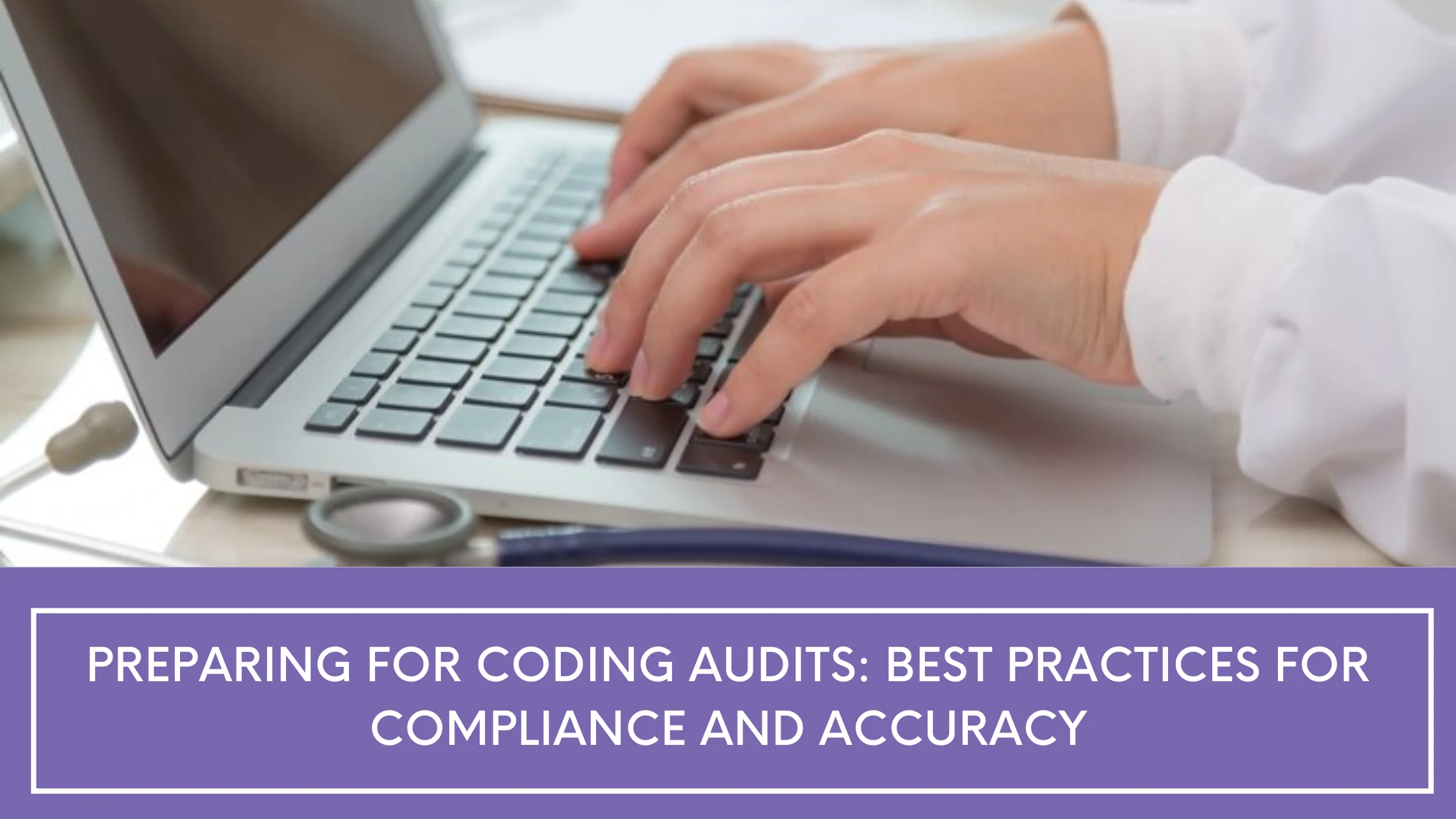Preparing for Medical Coding Services Audits: Best Practices for Compliance and Accuracy
In today’s healthcare environment, medical coding services and audits play an essential role in maintaining compliance, ensuring accurate reimbursement, and improving overall quality of care. A coding audit systematically evaluates clinical documentation and medical coding services to ensure they meet industry standards and regulations. With the increasing complexity of healthcare regulations and coding systems like ICD-10, CPT, and HCPCS, coding audits have become vital to prevent errors, minimize financial risks, and maintain regulatory compliance.
This article will provide a comprehensive guide on how to prepare for coding audits, with a focus on best practices for compliance, accuracy, and minimizing risks. Whether you are a healthcare provider, a coding professional, or an organization overseeing medical coding, understanding these principles can improve your coding accuracy and reduce the stress associated with audits.
Table of Contents
Why Coding Audits are Important
Before diving into the preparation process, it’s essential to understand the value of coding audits. Regular audits ensure that the medical coding is accurate and aligned with both clinical documentation and payer regulations. Here’s why coding audits are critical:
- Compliance: The healthcare industry is heavily regulated, with coding tied to strict compliance guidelines. Accurate coding ensures adherence to laws like the Health Insurance Portability and Accountability Act (HIPAA) and the False Claims Act (FCA).
- Financial Reimbursement: Accurate coding directly impacts the reimbursement process. Mistakes can lead to underpayments, overpayments, or denials, all of which affect a provider’s revenue cycle.
- Patient Care: Proper coding supports clear communication between healthcare providers and payers, ensuring patients receive the appropriate care and coverage.
- Risk Mitigation: Coding audits help identify and address errors early, preventing compliance violations and potential legal penalties. Proactive auditing reduces the risk of external audits and investigations by government entities or insurers.
Types of Coding Audits
There are different types of coding audits that organizations may conduct, depending on the scope and goals:
- Internal Audits: Conducted by the healthcare provider or facility, internal audits are designed to identify and correct coding errors before external reviews. These audits focus on consistency, accuracy, and documentation practices.
- External Audits: Performed by an external agency, these audits ensure that coding practices comply with industry regulations and guidelines. They often focus on specific areas of risk or concern, such as high-value claims or frequently denied services.
- Prospective Audits: These audits review claims before submission, ensuring that coding and documentation meet compliance standards. Prospective audits reduce the risk of denials and rejections by payers.
- Retrospective Audits: These audits are conducted after claims have been submitted. Retrospective audits focus on historical data to assess compliance and identify trends in errors or potential fraud.
Preparing for a Coding Audit: Best Practices
The key to successful coding audits is preparation. Here are the best practices that can help ensure compliance, accuracy, and minimal disruption during an audit.
1. Understand Coding Guidelines and Updates
Medical coding systems are continually updated, with changes to guidelines, codes, and payer requirements. For example, the ICD-10 and CPT code sets receive updates regularly, and it’s crucial for coding staff to stay current on these changes. Familiarity with payer-specific guidelines is equally important, as different insurance companies may have unique coding policies.
Action Steps:
- Subscribe to coding update bulletins from sources such as the American Medical Association (AMA) and the Centers for Medicare & Medicaid Services (CMS).
- Schedule regular training sessions for coding staff to review new updates and changes.
- Implement an ongoing education program that includes refresher courses on documentation, payer rules, and compliance regulations.
2. Implement Robust Documentation Practices
One of the most common causes of coding errors is insufficient or unclear clinical documentation. A well-documented medical record supports the coding process by providing clear, concise, and detailed information about the patient’s condition, treatment, and procedures.
Action Steps:
- Ensure that all clinical documentation includes specific details regarding diagnoses, treatment plans, and procedures.
- Encourage physicians and healthcare providers to use precise language and avoid vague or non-specific terminology.
- Develop documentation templates and tools that guide providers in capturing all necessary information for accurate coding.
3. Perform Regular Internal Audits
Regular internal audits provide a proactive approach to identifying and correcting coding issues before they become larger problems. These audits should be a part of your organization’s compliance strategy, and they should focus on high-risk areas or those prone to errors.
Action Steps:
- Develop an internal audit schedule that includes random and targeted reviews of medical records.
- Use a standardized audit tool or checklist to assess coding accuracy, documentation compliance, and medical billing practices.
- Provide feedback to coding and clinical staff on audit findings, and address areas for improvement through targeted training.
4. Leverage Coding Audit Technology
Automation and audit tools can streamline the audit process and increase accuracy. Advanced coding software and auditing platforms can identify errors, suggest corrections, and highlight areas of non-compliance. These tools can also track coding patterns and flag high-risk claims for further review.
Action Steps:
- Invest in coding and auditing software that aligns with your organization’s specific needs and workflows.
- Implement automated auditing systems that use artificial intelligence (AI) to detect coding discrepancies.
- Use data analytics to monitor coding trends and spot potential issues before they escalate.
5. Foster a Culture of Compliance
A culture of compliance begins with leadership and extends throughout the entire organization. When all staff members physicians, coders, and administrative personnel—are committed to accuracy and compliance, coding audits become smoother and more efficient.
Action Steps:
- Establish clear compliance policies and procedures that define the roles and responsibilities of each team member in the coding and billing process.
- Encourage open communication between coders and clinicians to resolve questions or uncertainties in documentation.
- Reinforce the importance of accurate coding and documentation through regular meetings, training, and educational resources.
6. Conduct Focused Training and Education
Education is a vital component of preparing for coding audits. By providing ongoing training to coders, billers, and clinicians, organizations can reduce the risk of errors and improve overall coding accuracy. Training programs should cover updates to coding guidelines, payer-specific rules, and common documentation issues.
Action Steps:
- Provide specialized training sessions for coding staff based on audit findings or areas where errors commonly occur.
- Offer continuing education opportunities, such as workshops, webinars, or certification programs, to keep staff up to date on industry changes.
- Implement a mentorship or peer-review program to allow experienced coders to provide guidance and feedback to junior staff members.
7. Monitor Key Performance Indicators (KPIs)
Monitoring key performance indicators (KPIs) related to coding and audits can help identify areas for improvement and track progress over time. Common KPIs include coding accuracy rates, denial rates, and compliance with payer requirements.
Action Steps:
- Establish KPIs that align with your organization’s coding and compliance goals, and use these metrics to evaluate performance.
- Regularly review KPI data to identify trends, patterns, or recurring issues that need attention.
- Use KPI findings to adjust training, policies, and workflows to enhance coding accuracy and efficiency.
8. Prepare for External Audits
External audits, whether conducted by government agencies or private payers, can be stressful. However, organizations that maintain strong internal controls and proactive audit practices are typically better prepared for these reviews.
Action Steps:
- Keep thorough records of all internal audits, training sessions, and corrective actions taken to address coding errors.
- Ensure that all documentation and coding practices are in alignment with external audit requirements.
- Designate a compliance officer or audit team to manage external audit requests and oversee audit preparation efforts.
9. Establish a Corrective Action Plan
Mistakes are inevitable, but what matters is how they are addressed. A corrective action plan (CAP) outlines the steps your organization will take to fix coding errors and prevent them from recurring. CAPs demonstrate a commitment to continuous improvement and compliance.
Action Steps:
- Develop a CAP template that includes a detailed analysis of coding errors, corrective actions, and follow-up measures.
- Implement a system for tracking the progress of corrective actions and ensuring accountability.
- Use CAPs as a learning tool, sharing key insights with coding staff and clinicians to improve future performance.
10. Maintain Open Communication with Auditors
Establishing a collaborative relationship with internal or external auditors can make the audit process less adversarial and more productive. Clear communication allows for a better understanding of audit findings and recommendations.
Action Steps:
- Designate a point person, such as a compliance officer or coding manager, to communicate with auditors throughout the audit process.
- Provide all necessary documentation, records, and clarifications in a timely manner.
- Be receptive to feedback and use audit results as a tool for improvement.
Common Challenges in Coding Audits and How to Overcome Them
Even with the best preparation, coding audits can present challenges. Here are some common issues and strategies to overcome them:
1. Lack of Clear Documentation
Challenge: Inadequate or vague documentation can make it difficult to support the assigned codes. Auditors may question the validity of claims, leading to denials or repayments.
Solution: Implement comprehensive documentation training for clinicians, emphasizing the importance of detailed notes. Use templates that prompt for the necessary level of detail, and provide feedback to clinicians when documentation falls short.
2. Inconsistent Coding Practices
Challenge: Different coders may interpret documentation in varying ways, leading to inconsistent coding across cases. This can be especially problematic in large organizations with multiple coding staff.
Solution: Standardize coding practices by implementing clear guidelines, utilizing coding software, and performing regular audits to ensure consistency. A peer-review system can help catch discrepancies early on.
3. Payer-Specific Guidelines
Challenge: Different payers have unique coding requirements, and failing to follow these guidelines can lead to claim rejections or audits.
Solution: Maintain an up-to-date repository of payer guidelines and ensure that coders are trained to handle payer-specific rules. Include payer guidelines as part of your audit checklist.
In short, Preparing for coding audits is an essential part of maintaining compliance, ensuring accurate reimbursement, and reducing risks. By implementing best medical practices, including regular training, internal audits, robust documentation, and technology solutions, healthcare organizations can minimize errors and remain compliant with industry regulations. Cultivating a culture of compliance and continuous improvement will not only help you navigate the complexities of coding audits but also enhance your organization’s overall efficiency and financial performance.
By following these steps and maintaining a proactive approach, your organization will be well-prepared for any audit internal or external and positioned to meet the ever-evolving demands of the healthcare industry.
By partnering with Practolytics, a leading provider of revenue cycle management and healthcare analytics solutions, organizations can leverage expert coding support, streamlined audit processes, and advanced technology to ensure compliance and optimize financial performance.
DOWNLOAD WHITE PAPER – Navigating the Complexity of Wound Care Billing
Talk to Medical Billing Expert Today — Get a Free Demo Now!






